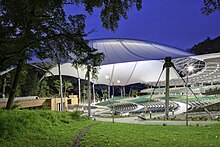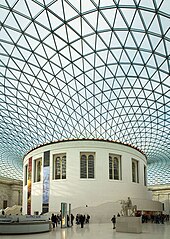Shell (structure)



A shell is a three-dimensional solid
Thin-shell structures (also called plate and shell structures) are lightweight constructions using
Definition
A thin shell is defined as a shell with a thickness which is small compared to its other dimensions and in which deformations are not large compared to thickness. A primary difference between a shell structure and a plate structure is that, in the unstressed state, the shell structure has curvature as opposed to the plates structure which is flat. Membrane action in a shell is primarily caused by in-plane forces (plane stress), but there may be secondary forces resulting from flexural deformations. Where a flat plate acts similar to a beam with bending and shear stresses, shells are analogous to a cable which resists loads through tensile stresses. The ideal thin shell must be capable of developing both tension and compression.[2]
Types
The most popular types of thin-shell structures are:
- Concrete shell structures, often cast as a monolithic dome or stressed ribbon bridge or saddle roof
- Lattice shell structures, also called gridshell structures, often in the form of a geodesic dome or a hyperboloid structure
- pneumatic structures.
See also
- Monocoque
- Diagrid
- Stretched grid method
- List of thin shell structures
Persons related:
References
- ^ O.C. Zienkiewicz and R.L. Taylor. The finite element method for solid and structural mechanics.
- ISBN 9780849315695.
Further reading
- ISBN 9780415419673.
- Suchov, Vladimir G. (1990). Rainer Gaefe (ed.). VLADIMIR G. SUCHOV 1853-1939; Die Kunst Der Sparsamen Konstruktion (1st ed.). Stuttgart: Deutsche Verlags-Anstalt. ISBN 9783421029843.
External links
- Thin-shell structures
- Double thin-shells structures
- Hypar & Concrete Shells
- Past and Future of Grid Shell Structures
- Shape optimization of Shell and Spatial structure
- Lattice Shell for Space Vehicles
- International Association for Shell and Spatial Structures
